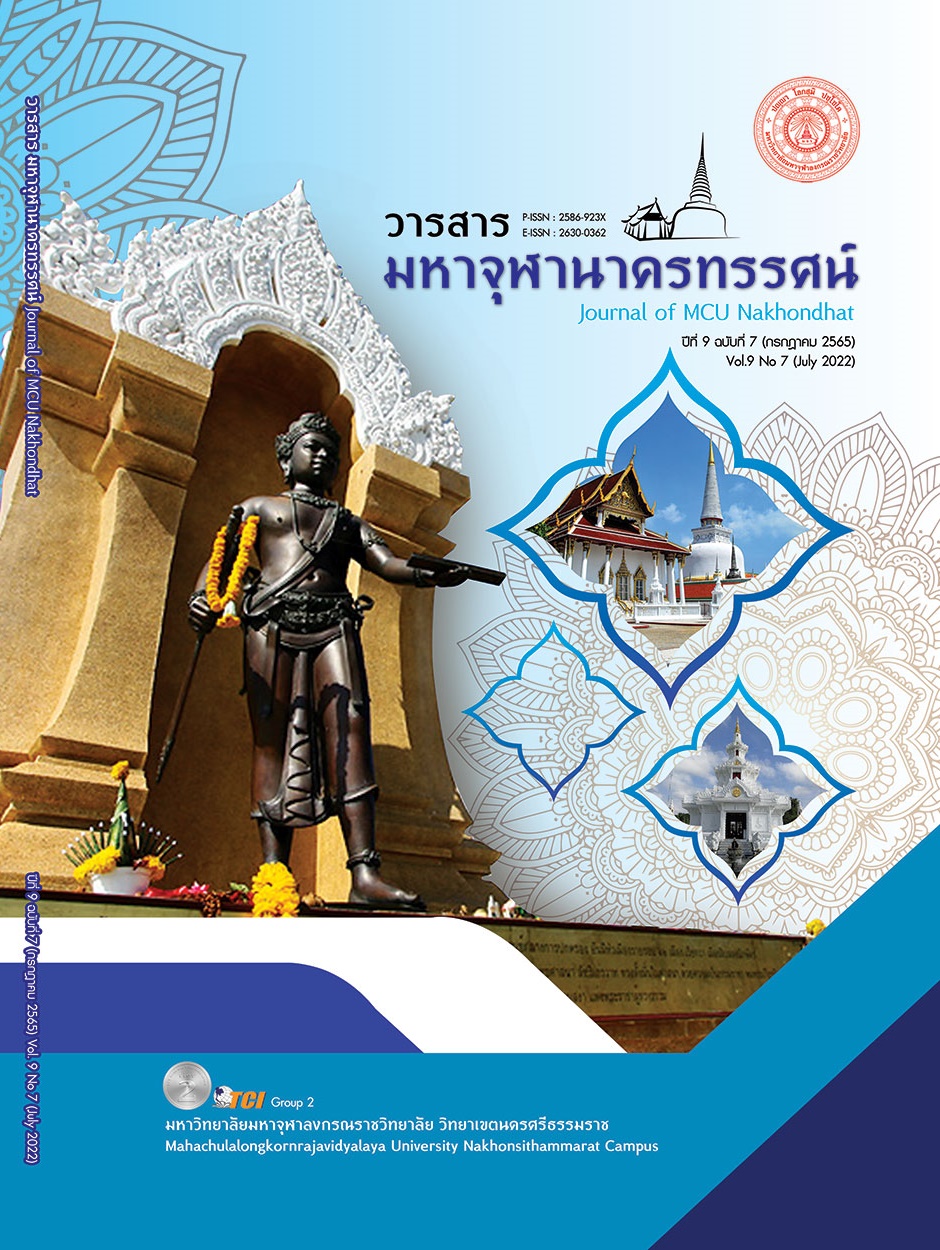CHANGING HEALTH BEHAVIORS FOR THE ELDERLY IN A BUDDHIST WAY AFTER A NEW LIFESTYLE
Main Article Content
Abstract
This article deals with the change of health behaviors for the elderly in a Buddhist way after living a new lifestyle. To analyze the behavior of the elderly after the outbreak of the emerging corona virus that there should be scientific principles and Buddhist principles to integrate together. Through the collection of literature reviews, it is a tool to analyze the content of the elderly health behavior change cases. by suggesting the concept of quality of life Indicators for measuring quality of life Health behavior change for the elderly Factors leading to endemic diseases and three principles of dharma leading to trilak life the situation of the coronavirus disease 2019 (COVID-19) epidemic among the elderly, a large vulnerable group in Thailand There must be a change in health behaviors, both physically and mentally, despite COVID-19. will be endemic By adhering to the public health principles of the 3 districts, namely food, exercise, and mood 2 S.: refrain from smoking, refrain from drinking alcohol and bring the principles of Buddhism to support such as the principle of leading life to reach the goal (attha) 3 steps Step 1: Dittadhamikatta The goal of sight or the present benefit, the second stage, Samparayikatha It is the goal that is beyond the eyes or the benefit in front of the eyes. The third step, Paramattha, is the ultimate goal or the greatest benefit. and reinforced with three principles of dharma leading to the trinity of life: 1) Impermanence, which is impermanence; 2) Tukkha (stress and conflict) is suffering; 3) Soullessness, which is non-self or non-existence. the true self of things and cannot be controlled to remain in accordance with their own intentions The elderly will have a good quality of life in society happily.
Article Details

This work is licensed under a Creative Commons Attribution-NonCommercial-NoDerivatives 4.0 International License.
References
กรมสนับสนุนบริการสุขภาพ (สบส.). (2563). เปิดผลพฤติกรรมสุขภาพ 3 อ. 2 ส. ยุค New Normal. เรียกใช้เมื่อ 2 เมษายน 2565 จาก https://www.hfocus.org › content › 2020/08
กรมอนามัย กระทรวงสาธารณสุข. (2562). คู่มือแนวทางการขับเคลื่อนแผนปฏิบัติการการส่งเสริมสุขภาพผู้สูงอายุ กรมอนามัย ภายใต้แนวคิด“สุขเพียงพอ ชะลอชรา ชีวายืนยาว”ประจำปีงบประมาณ พ.ศ. 2563-2565. เรียกใช้เมื่อ 20 มีนาคม 2565 จาก http://164.115.41.179 › sites › default › files › คู
กรมอนามัย กระทรวงสาธารณสุข. (2563). รายงานประจำปี 2563 สำนักอนามัยผู้สูงอายุ การประชุมเชิงปฏิบัติการพัฒนาองค์กรในการดูแลส่งเสริมสุขภาพผู้สูงอายุแบบฐานวิถีชีวิตใหม่. เรียกใช้เมื่อ 14 มีนาคม 2565 จาก https://eh.anamai.moph.go.th › filecenter
กระทรวงสาธารณสุข. (2562). หลักสูงวัย'ไม่ล้ม ไม่ลืม ไม่ซึมเศร้า กินข้าวอร่อย. เรียกใช้เมื่อ 20 มีนาคม 2565 จาก https://www.thaihealth.or.th › Content › 48282-หลักสู
กองทุนลักษณา ลีฬหาชีวะ. (2562). ธรรมะเพื่อชีวิตพ้นทุกข์ 4 (พิมพ์ครั้งที่ 1). เชียงใหม่: บริษัท ธรรมสภา บันลือธรรม จำกัด. เรียกใช้เมื่อ 4 มิถุนายน 2565 จาก https://www.dhammabylf.com › document-project-9
ชลธิชา มะลิพรม. (2561). คุณภาพชีวิตของบุคลากรทางการศึกษา. เรียกใช้เมื่อ 31 มีนาคม 2565 จาก https://so05.tci-thaijo.org › article › Download
ไทยรัฐออนไลน์. (2565). โรคประจำถิ่นโควิดเหมือนไข้หวัดใหญ่ไม่รุนแรงแต่แพร่เชื้อง่ายยอมรับ. เรียกใช้เมื่อ 31 มีนาคม 2565 จาก https://www.thairath.co.th › ข่าว › การเมือง
พระพรหมคุณาภรณ์ (ป.อ.ปยุตโต). (2555). ธรรมนูญชีวิตฉบับปรับปรุงใหม่. (พิมพ์ครั้งที่ 190). กรุงเทพมหานคร: บริษัทอมรินทร์พริ้นติ้งแอนด์พับลิชชิ่ง จำกัด (มหาชน).
พระไพศาล วิสาโล. (2555). ธรรมนูญชีวิตฉบับปรับปรุงใหม่. (พิมพ์ครั้งที่ 190). กรุงเทพมหานคร: บริษัทอมรินทร์พริ้นติ้งแอนด์พับลิชชิ่ง จำกัด (มหาชน).
พระอธิการบรรยง ปิยธโร (ทุมขันธ์). (2561). หลักไตรลักษณ์ในพระพุทธศาสนาเถรวาท. เรียกใช้เมื่อ 4 มิถุนายน 2565 จาก https://yongyutp.files.wordpress.com › 2018/07
มูลนิธิสถาบันวิจัยและพัฒนาผู้สูงอายุไทย. (2564). สุขภาพกาย-จิตใจย่ำแย่วิกฤตที่ผู้สูงอายุต้องเผชิญในยุคโควิด19. เรียกใช้เมื่อ 20 เมษายน 2565 จาก https://thaitgri.org ›
วิฑูรย์ สิมะโชคดี. (2564). คุณภาพคือความอยู่รอดตอน คุณภาพชีวิต...อยู่ที่ใคร? เรียกใช้เมื่อ 31 มีนาคม 2565 จาก https://www.matichon.co.th › คอลัมนิสต์
สนธิ คชวัฒน์. (2564). ชีวิตนิวนอร์มอล ถึงวันวัยเกษียณ-ไทยรัฐออนไลน์. เรียกใช้เมื่อ 22 มีนาคม 2565 จาก https://www.thairath.co.th › news › politic
Baster, N. (1985). Social indicator research: some issues and debates. In J. G. M. Hilhorst and M. Klatter (eds.), Social Development in the Third World: Level of Living Indicators and Social Planning. London: Croom Helm for the Institute of Social Studies.
Campbell. (1980). The Demand for Life Insurance: An Application of the Economics of Uncertainty. The Journal of Finance, 35(5), 1155-117.
Cullen. (1978). Measuring the impact of social policies. Paper presented at the Ninth World Congress of Sociology. Uppsala, Sweden: unpublished.
Newman, S. (1975). Objective and subjective determinants of prospective residential mobility. Social Indicator Research, 2(2), 53-63.
Rogerson et al. (1989). Indicators of quality of life: some methodological issues. Environment Planning, 21(2), 1655 - 1662.


